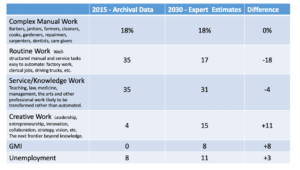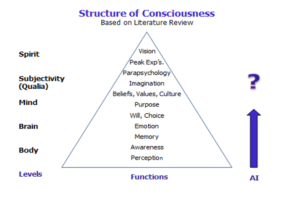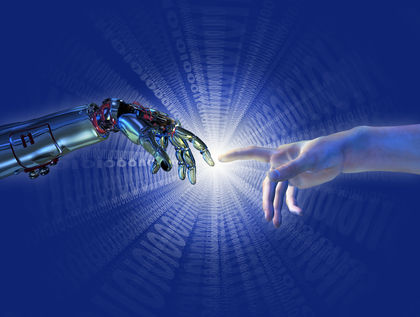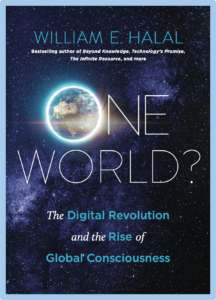The AI Revolution has created a palpable fear that ”The robots are coming to take your jobs!” Studies conclude that roughly half of present jobs could be lost to automation, even professional work, possibly leading to mass unemployment and social upheavals
TechCast asked our thought leader-experts to forecast the future distribution of jobs across the occupational spectrum for the year 2030. The results below tell a different story that opens the way to a creative society.
Results and Conclusions: Muddling Through
Results are tabulated below and show that the majority of experts believe that a reasonable path can be found through this difficult transition. We call this the “Muddling Through Scenario.” This is a “middle” scenario in which an organic combination of market forces produce new creative jobs and government support offers GMI benefits, containing unemployment to tolerable levels.
TechCast experts collectively judge that humanity will find its way safely through the coming AI/robotics crisis as the world reaches a more fully automated stage of development about 2030. Automation is likely to eliminate about 22% of routine jobs but the loss is likely to be compensated by roughly 8% of workers gaining a guaranteed minimum income (GMI) and roughly 15% finding new jobs in “creative work.”
Expert Survey Results for OECD Nations in 2030 (N = 53)

The Possibility of a Creative Society
This is a modest study, and many complex issues are involved, yet we think this forecast provides useful insights into how the AI issue can be resolved.
We conclude that government support and innovative enterprise could absorb this AI threat and turn it into a new domain of creativity.The adoption of GMI and the growth of new creative jobs are likely to keep unemployment contained at 11 percent or so, which would be bad but not a major crisis. Furthermore, the widespread use of AI should increase the level of knowledge and intelligence to unprecedented levels, fostering a society of creative change and understanding.
The key is to recognize that AI can automate routine knowledge work, but there exists a huge unexplored economic domain beyond knowledge—creativity, entrepreneurship, vision, collaboration, diplomacy, marketing, supervision, and other higher-order functions that are uniquely human. See the figure, “Structure of Consciousness.” Advanced AI may be able to solve tough problems, but it cannot provide vision, purpose, imagination, values, wisdom, and other capabilities that are essential for sound leadership and tough choices.

Intelligent machines are likely to take over routine service and knowledge tasks, but the technology will remain limited and people will always want a real person to provide human contact and handle tough issues. Staff is growing rapidly in universities, hospitals, research institutes, and other advanced settings for these reasons. The service and knowledge work sector could grow to 50−60 percent by 2030.
In the end, rather than diminishing people, the net effect of AI may be to enhance the value of these higher-order talents that are a unique gift to humanity.This conclusion may seem contrary to many who are convinced a disaster looms ahead. We respectfully suggest that, yes, the robots are coming to take your jobs, but more creative work and better support can also foster a more innovative, prosperous and thoughtful civilization.
This article is a short version of the AI and Future Jobs published in Foresight: The journal of future studies, strategic thinking and policy.




